
Eppi is the second series of games in the Paper Point-and-Click line of games from Lookout Games.

The first game in this series was Cantaloop by Friedemann Findeisen: see our review here! We loved Cantaloop so much that it made the #1 spot on our Top 10 Cooperative Games of 2021! This was a series of three games: we liked all three of them! See here, here, and here!

What makes these games so interesting is that they are the paper book equivalent of the old “point-and-click” video games!

Think of the Secret of Monkey Island, King’s Quest, or the more recent Thimbleweed Park. Players “point-and-click” at objects in their world (on the computer screen), combining objects to solve puzzles! Players also move around, exploring the world they play in!

These games are all about combining objects and exploring the world, trying to solve the puzzles in the story you uncover along the way.

However, instead of a computer screen, these Paper point-and-click games have book and cards! You combine cards, solve puzzles, and flip through the book exploring the story therein!

Let’s take a look at Eppi!
Unbooking
We can’t have an unboxing, as this is mostly a book. So this is an unbooking.

Eppi is a book first and foremost: everything else is contained in the front pouches at the front of the book.
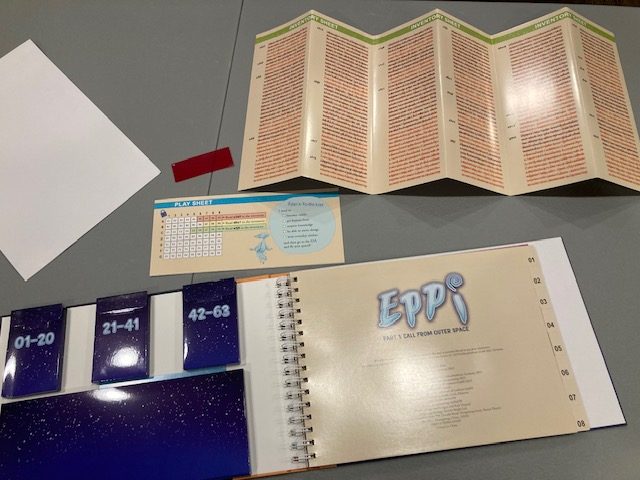
The big bottom pouch contains the inventory page, the play sheet, a postcard map, but most importantly … the red decoder!

This little red decoder is the main gimmick of the game! Hidden text in the book waits for you to unearth via the red decoder! The red decoder reveals important text in the adventure! See above as you encounter Eppi for the first time in the hall!

Most of the “objects” you will interact with come from the three card pockets. As you reveal text in the game, you will uncover more cards which you can combine!
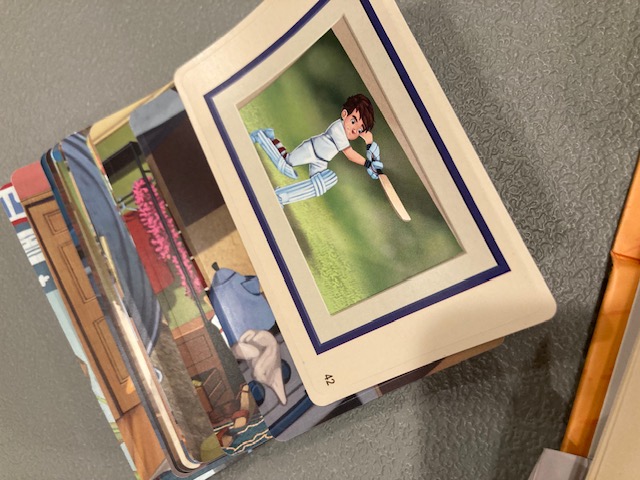
One thing that’s differentiates Eppi from the original Cantaloop series is that about a third of the cards are stickers rather than cards: see above That’s right, this is a legacy game (but see below)! As you explore, you will put stickers on locations to reveal new options or hide old options that are no longer relevant!

The map tells you where you can go in the house, and the corresponding pages of the book. Note that you can’t get into certain rooms until there are unlocked via triggers! (You can’t get to Saira’s Study until you hit trigger D4!)

The play sheet comes with a little matrix of “triggers”: as you explore and combine objects, you will mark triggers on the sheet to show you’ve “accomplished certain things”.
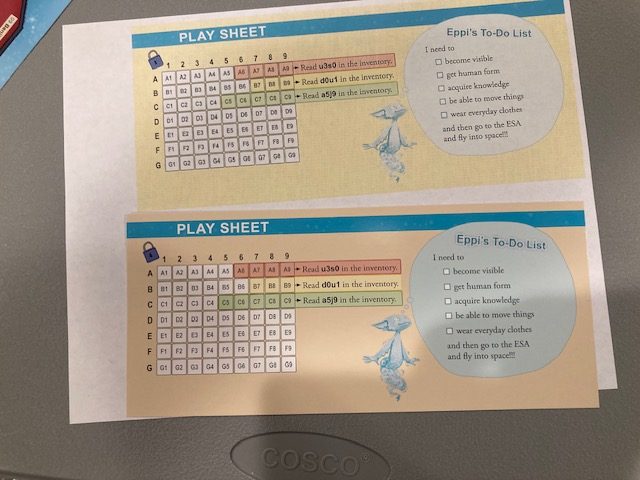
This same Play Sheet also has your “TODO” list: in order to win the game you have to accomplish 5 goals! See above. (Why are there two Play Sheets above? Keep reading!!).
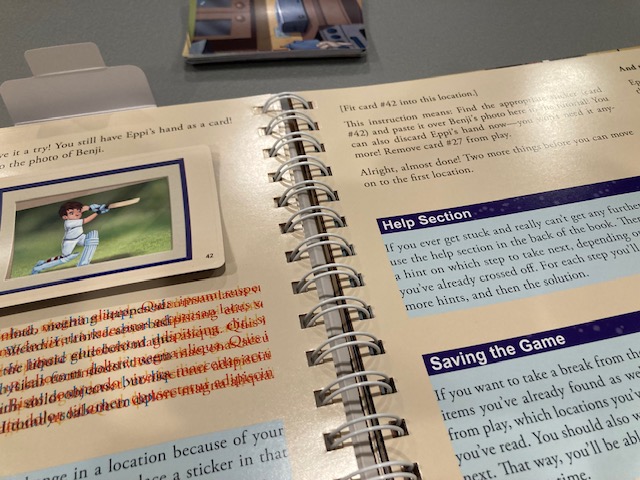
The rest of this game is the book!
- The introduction and tutorial is fabulous and tells you how to explore and combine objects!
- The next section has the 12 Locations (2 pages each) in the game
- The next section are Cut-Scenes (further expansion of the plot as you move forward)
- Finally, the last section is a Help Section

This game looks great! It has a very family-friendly and welcoming vibe to its art. It’s very clear this is aimed at younger kinds and families! I mean, it says that on the cover, but the art choices reinforce that.
Legacy or Campaign Game?

Since you are supposed to put down stickers as you play, this is pretty much a legacy game! You won’t be able to replay it again … or will you? You really can’t remove the stickers (they are very sticky), and you also mark up the Play Sheet with the triggers. So, this is a legacy game (but see below)! And honestly, what kid doesn’t like putting on stickers? For some families, the stickers may the best part of the game.
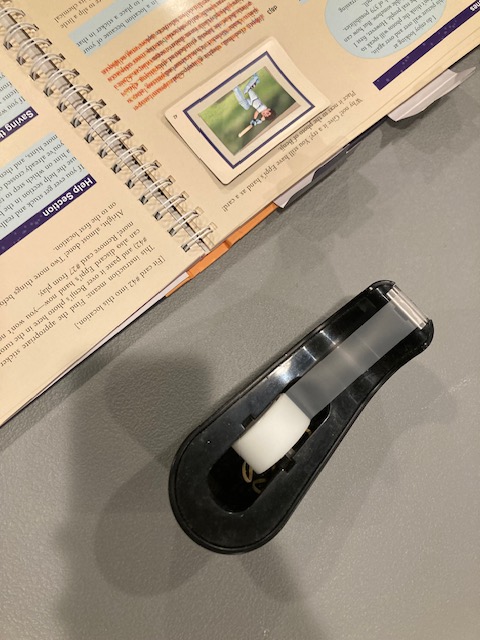
Having said that … If you are very careful, you can reset the game: you can use little pieces of tape to “tape” the stickers in the book rather than stick them.
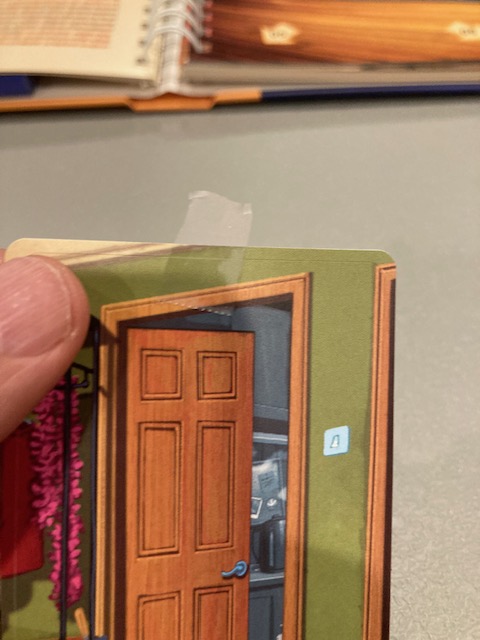
I was able to play the entire game all the way through, using just little bits of tape on the edges to hold the stickers down (see above). After I was all done, I was able to reset the entire game by just carefully pulling off the tape! If you use small, little pieces of tape, you can keep the stickers down without too much work to remove it later. The bigger the piece of tape, the harder it will be to remove!

The only thing other thing you need to do to reset it: make a copy of the trigger sheet! That’s why I have two copies of the Play Sheet above: one is a copy!

So, with those two “tricks” (tape and a copy of Play Sheet), I was able to reset the back to pristine condition after full playthrough (it did take a little bit of time to undo the tape).

It’s a little fiddly to keep making little pieces of tape, but I suppose no more fiddly than trying to stick the sticker on and aligning it just so. However, I suspect the best way to play is to just put the stickers in: the best part of being a kid is playing with stickers!
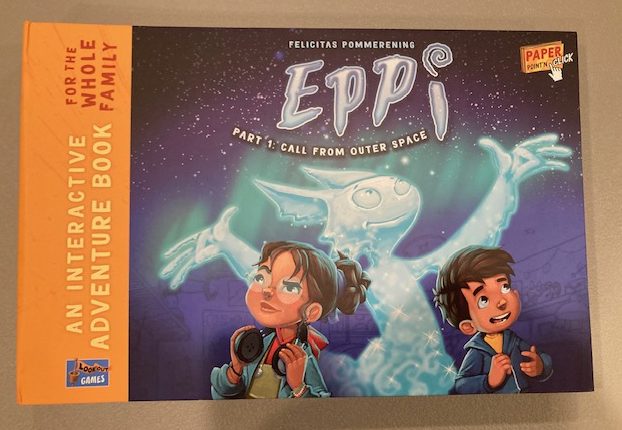
The only reason you may not want to put stickers in your game is that this is a 3-Part series (I think): this is Part I after all. The next Eppi book is “probably” a year away, so you may want to replay this game again just before the next one comes?
In general, it’s probably more fun to put the stickers in (it’s a legacy game)! If you are just a little careful, you can get by and make it resettable (making it a campaign game). It’s up to you!
The World

Most locations in this world look like the above: the left side of the page has a lot of hidden text (to decode with the red acetate) and the right side of the page is a picture of the room you are currently in (with objects you can combine with). As you explore the room, you will combine objects and read some of the text on the left!

The typical way to combine objects is to align the left side of a card with either a location or the right side of another card. If the two letter code (u6w6 from the picture above) corresponding to the arrows shows up on the appropriate sheet, you can read it with the red decoder! Otherwise, if there’s no such code, nothing happens! (It’s like trying to combine a bowling ball and a feather, it doesn’t make sense, so nothing happens).
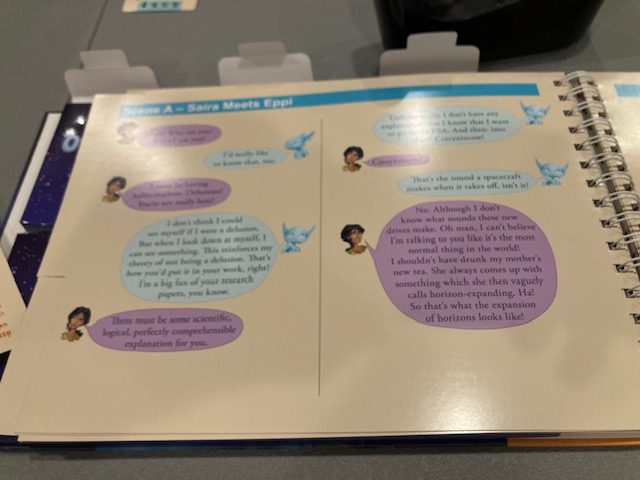
Sometimes, the little red decoder will tell you to read a cut-scene: it looks like the above, where characters talk to each and further push the plot and character development.
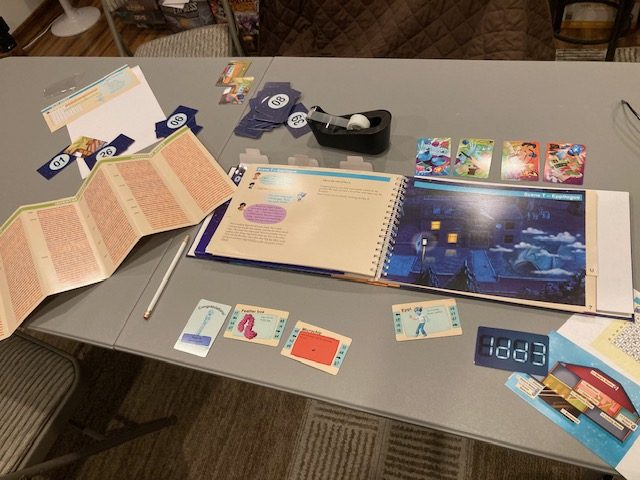
This game is all about “trying” things in this world: Do these objects combine? Do this object combine with this location? Nothing here? Let’s look around at a new Location! You try stuff, go to new Locations, and just keep exploring this world.
Flow

This is an adventure game: you will start off making tons of progress, then slowly and slowly start making less and less progress until you hit a wall. Eppi has the same ebb and flow as most adventure games: sometimes, when you are stuck, you just have to go around and just “try stuff”! Arguably, the least exciting thing about adventure games is the brute force approach is sometimes needed: it can be boring and soul-crushing to just try stuff that makes no sense. Even worse, it’s harder in this game because you physically have to do a lot more work to just “try stuff” (turn pages, combine items, look up text, see if it decodes: Lather, rinse, repeat). But once you break through that wall, it’s so exciting! The story picks up again, and things make sense again!

Eppi is an adventure game! Every point-and-click adventure game I have ever played has this same flow: lots of cool stuff then some frustration, then excitement, some more frustration, then more excitement!
Help

If you do get stuck, there is a Help Section in the back of the book (see above). In this case, you lookup help sections by seeing what trigger conditions you are missing! You correlate your Play Sheet and find the lowest trigger you are missing! This is usually where the problem is!

A few times, I had to look up some help, but I had to look at more than one trigger to find what I needed. But it was there! It’s a little confusing the first few times you try to use the help. One of my biggest problems was that I sometimes forgot to mark off a trigger, so that prevented me from moving forward!
This isn’t the best Help system, but it seemed to work for me once I kept at it.
Story: Solo vs Cooperative

So, Eppi is a family friendly story! In fact, the main characters of the game are a family! Mom and Dad and some kids of all ages! As you explore this game, a story moves forward. But, why read a story when you can play it?
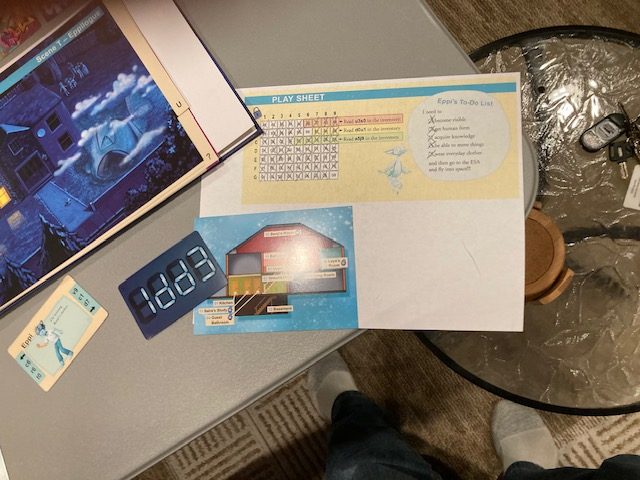
The two main ways to play Eppi are solo or cooperative. Cantaloop (the first of this kind of games) definitely felt like more of a solo game, although arguably you could play it cooperatively. Eppi feels like it is better at being both solo and cooperative: it absolutely works solo (that’s the way I played it), and then it absolutely works in a family environment (a 7-year old girl and her family gave us some feedback).
Solo

I ended up playing the entire game solo one Sunday: it took about 5 hours (the box says 5-8 hours, so that’s accurate).
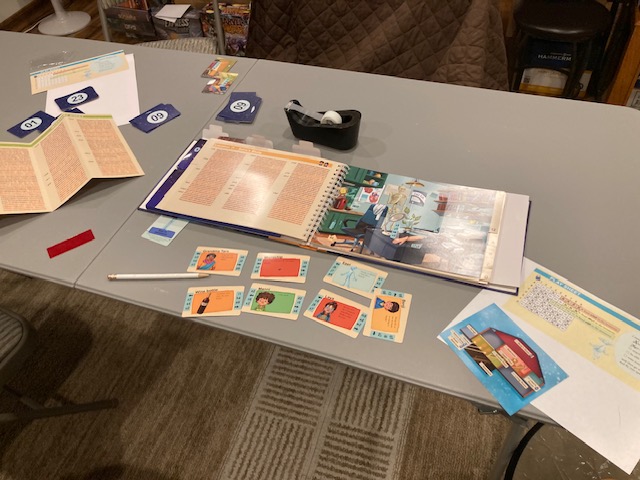
I definitely stopped and took a break at some points when I was getting frustrated, so wall-clock time was probably more like 7 hours, with 5 hours of play and 2 hours of taking a break.

This would be easy to reset if you needed to: you just take a picture of the cards you have, and put everything away. If possible, it’s probably just a little easier to keep everything set-up between sessions, but you may not have that luxury.

The solo game worked pretty well. I got stuck a few times and had to consult the Help. In general, it was pretty fun.
Cooperative Family Mode
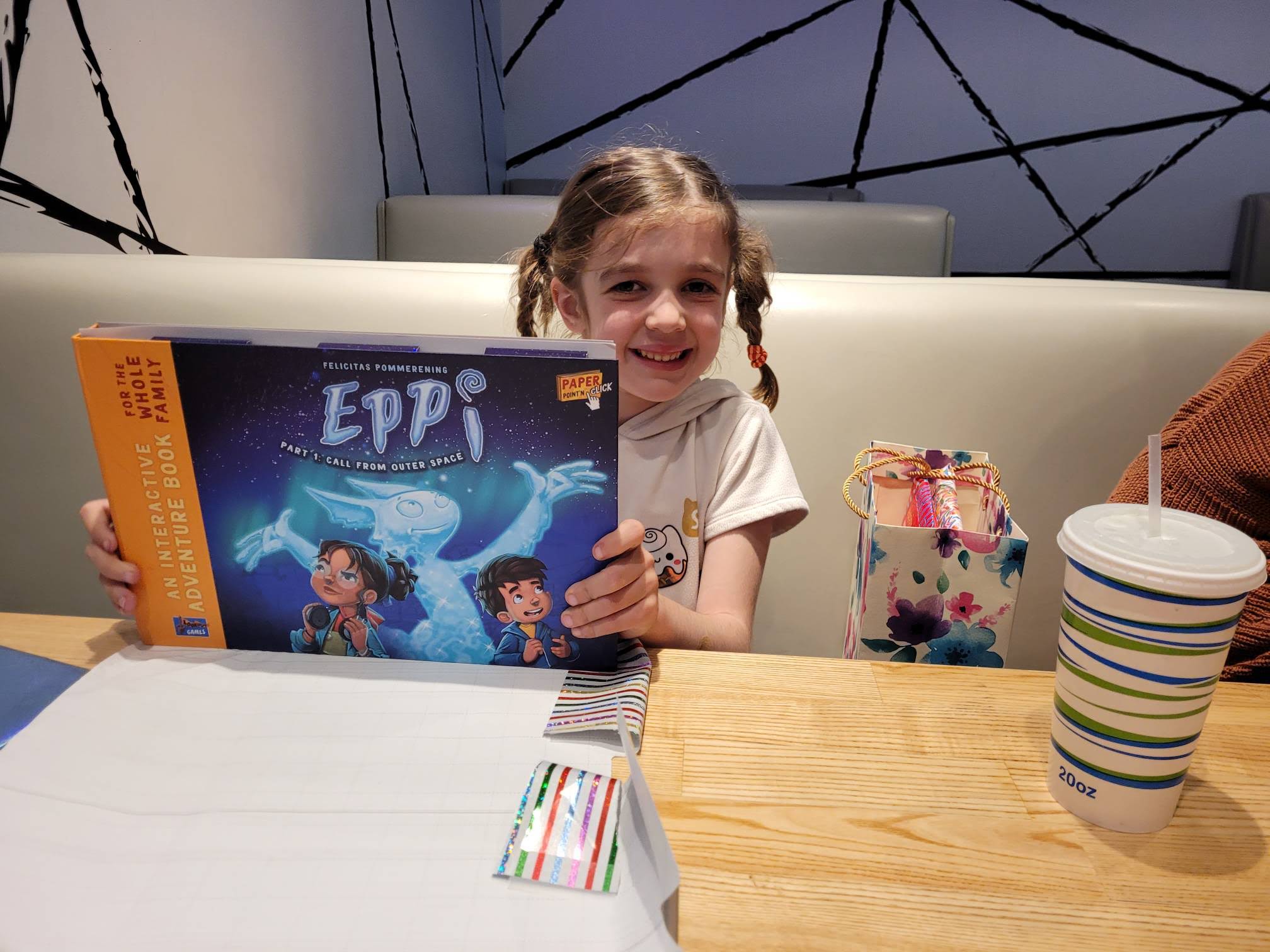
What I Liked

Turning pages to explore and move through Locations worked great: the binding is good for that, and the pages are high quality: they definitely learned from the Cantaloop experience! The very first Cantaloop game had lesser quality paper, and it actually made a difference, as you were much more careful turning pages (afraid to tear them)! With the higher quality paper and binding, it’s easy to make your way through the book.

The stickers are cool. In Cantaloop, they “new scenes” were on cards, and if you turned the page, you would have to reset the scenes. By putting the “new scenes” on stickers, you can work through the book quicker, as you don’t have to worry about “new scenes” flopping around! Besides, stickers are cool … especially for kids! (And, like we said, if you are careful you can get the equivalent experience with taping the cards, but you should use the stickers!!!)

By making the Eppi game more “family-friendly” (to be clear, Cantaloop was NOT family-friendly), it opens the door to cooperative play more than the original Cantaloop: the story and art is very inviting in Eppi! It’s just something the whole family can be immersed in. This definitely feels the cooperative mode is much more accessible. I loved Cantaloop, but it really is best as a solo game. I think this might Eppi might be more fun as a cooperative game.

I adore this genre: the Point-And-Click Adventure game is fairly rare! I am so glad Cantaloop did well enough to spawn further games in this genre. I love this genre so much! More games like this please!

The tutorial was very good: it showed what you can and can’t do when you combine objects.
What I Didn’t Like
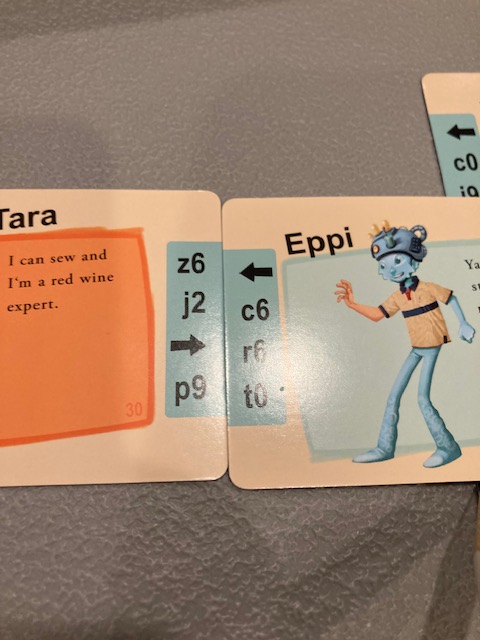
In the original Cantaloop, when you combined cards, the lowest number card ALWAYS had to be on the right: this reduced the number of ways you could try to “combine” two objects. Why didn’t Eppi adopt this rule? You effective may double the amount of work you have to do to combine objects, as you may have to combine the cards twice!

I liked the story here, I did. But, the wit of the original Cantaloop isn’t in here … which makes the game seem like a little more work. Even if you got a puzzle wrong in Cantaloop, frequently there were funny jokes or amusing turns-of-phrase! So, every time you worked for clue, you got rewarded by either advancing the plot or some joke! I didn’t realize until I played Eppi that the jokes in Cantaloop distracted me from all the physical work you have to do to move the story forward! Let’s be clear: there is a lot of physical activity of moving cards, combining objects, reading red text, turning pages, marking triggers, turning to cut scenes! Whew! All physical activities!
I think some of this will go away if you play cooperatively, as the game is more about the cooperative experience with your family. But I think the “work” to move the game forward is a little more prevalent in Eppi if you solo it.

The final puzzle was pretty hard. I feel like it was almost out-of-scope/too hard for a family game: I suspect you will have to use the Help System to finish the game. That last puzzle seemed a little too much, even with a whole family looking at it.
Conclusion

I am so happy there are more Interactive Adventures like Cantaloop! Eppi is a fun game solo or cooperatively, but I think the best place for it is the cooperative game with the family …
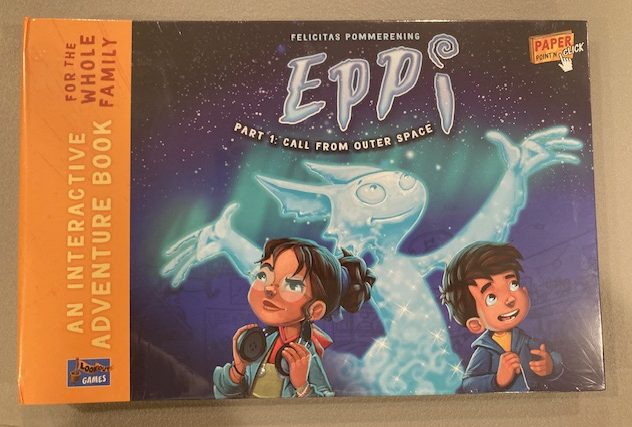
… and that’s what the cover says! It doesn’t lie!
I like Cantaloop better overall, partly because of the non-stop humor, but I had a lot of fun with Eppi. This is a solid 7.5 solo, maybe 8 cooperatively with your family.